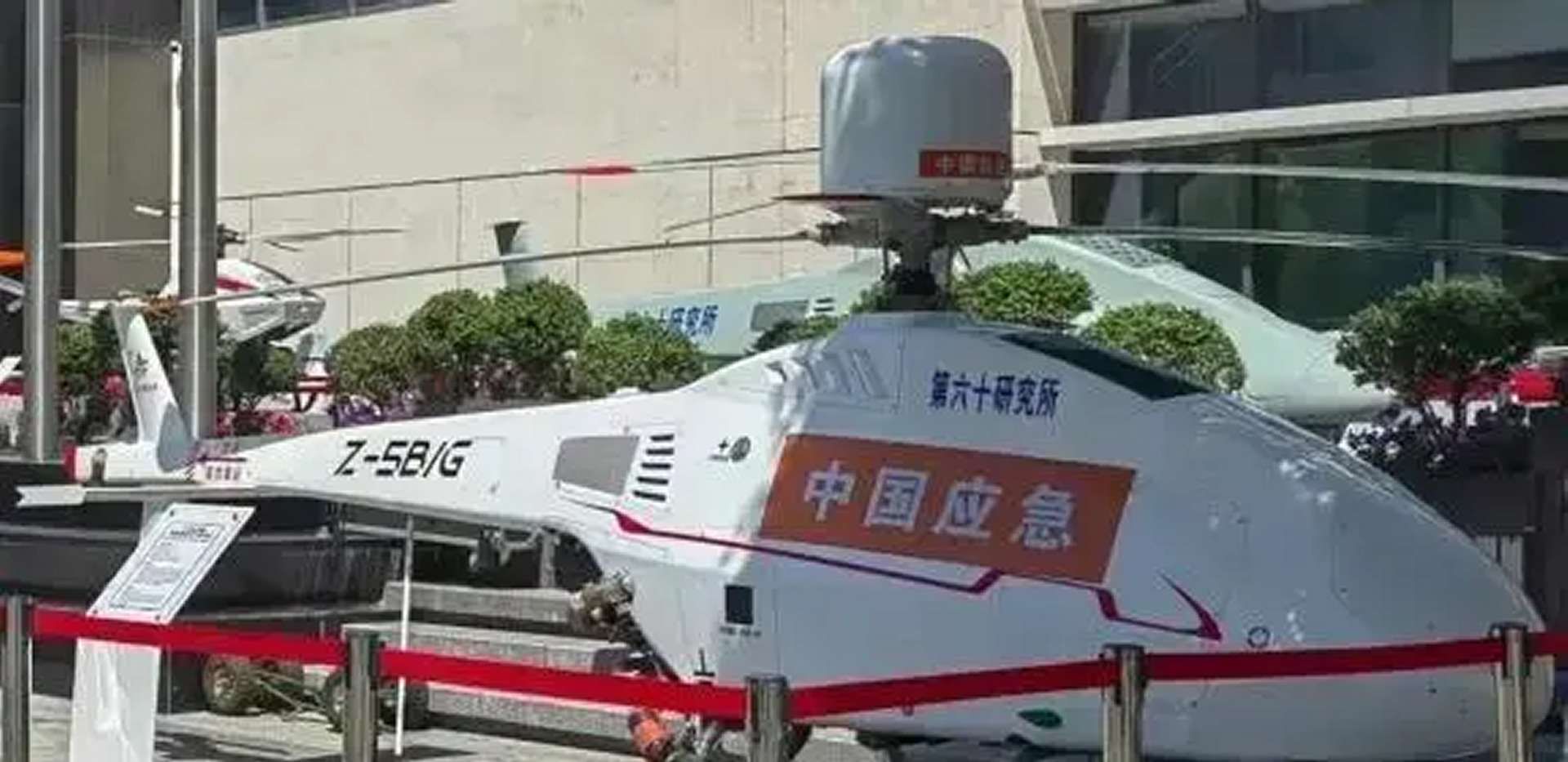Breaking news
China's 60th Research Institute presents Z-6B helicopter drone to improve naval accuracy.
As reported by Rupprecht_A on May 26, 2024, the Z-6B unmanned helicopter was recently showcased at the Nanjing Low-altitude Economic Development Conference by the 60th Research Institute of the Rongtong Research Academy. This event highlighted various products of this company, including the Z-6B, Z-5B/G, and Z-3N. The Z-6B's shipborne capability is expected to enhance the accuracy and combat effectiveness of naval artillery, supporting the growth of the country's helicopter industry and military strength.
Follow Army Recognition on Google News at this link

According to available information, the Z-6B could feature a sleek design with reduced radar reflectivity, advanced optical and AIS systems, and perform multiple military functions, including reconnaissance, attack, anti-submarine warfare, and port blockades. (Picture source: Chinese social media)
The Z-6B reflects its heritage through its designation, paying tribute to the original Z-6 helicopter, China’s first turboshaft-powered helicopter introduced over 60 years ago. While the Z-6B retains the numbering of its predecessor, it signifies a notable technological advancement.
During the 1960s, China's helicopter industry was in its early stages, heavily reliant on the Soviet Mi-4 helicopter, known locally as the Z-5. The Z-5 met immediate needs but had limitations due to its piston power system and outdated technology. In 1966, the Chinese Third Ministry of Machine Building tasked Factory 122 with developing a more advanced helicopter, leading to the creation of the Z-6 with the innovative 792 turboshaft engine. Despite successful test flights, the Z-6 faced challenges during mass production, resulting in the project's termination. This experience, however, provided valuable insights for China's helicopter industry.
In the years following the Z-6 project's end, China continued to explore and adopt new technologies, introducing models like the Z-9 "Dolphin" and the Z-8 "Super Hornet." These imports revitalized the domestic helicopter industry but highlighted the need for independent development. According to available information, the Z-6B could feature a sleek design with reduced radar reflectivity, advanced optical and AIS systems, and perform multiple military functions, including reconnaissance, attack, anti-submarine warfare, and port blockades. Its shipborne capability allows it to operate from platforms such as the Type 075, potentially enhancing naval operations by improving artillery accuracy and overall combat effectiveness. Its low altitude and high concealment characteristics are said to make it challenging for enemies to detect.
The Z-6B's claimed technical specifications include a maximum take-off weight of 1,600 kg, a task load of 250 kg, and a battery life of 8 hours. It has a maximum level flight speed of 230 km/h, a cruising speed of 200 km/h, and a control radius of 200 km. The helicopter can hover at altitudes up to 3,000 meters without ground effect and has a practical ceiling of 5,000 meters. It is adaptable to sea state level 5 conditions, enhancing its operational versatility in various maritime environments.

By relaying missile signals, the Z-5B ensures better target accuracy, addressing trajectory deviations caused by long-range distances. The Z-5B/G, equipped with electro-optical pods and radio monitoring payloads, also offers extensive aerial radio monitoring capabilities, aiding the Chinese government in managing electromagnetic environments and handling illegal signal sources. (Picture source: Chinese social media)
Among the other showcased products, the Z-5B/G unmanned helicopters received significant attention. The Z-5B/G is a light unmanned helicopter based on the modified Z-5B, which has significantly improved its flight performance in plateau areas by optimizing the rotor and engine. Its small overall size makes it easy and flexible to use. By carrying different mission equipment, the Z-5B/G can perform a variety of tasks, including reconnaissance, positioning and calibration, damage assessment, border patrol, communication relay, transportation, and delivery.
The entire system can be carried on a medium-sized, highly mobile 6x6 general-purpose tactical truck with integrated control and storage modules to meet China's railway transportation requirements and achieve full-area mobilization. Additionally, the Z-5 series helicopters are equipped for emergency communications and signal relay, effectively extending the range and accuracy of long-range missiles like the Eagle Strike-18 and Eagle Strike-12. By relaying missile signals, the Z-5B ensures better target accuracy, addressing trajectory deviations caused by long-range distances. The Z-5B/G, equipped with electro-optical pods and radio monitoring payloads, also offers extensive aerial radio monitoring capabilities, aiding the Chinese government in managing electromagnetic environments and handling illegal signal sources.
The known technical specifications of the Z-5B/G include a maximum take-off weight of 530 kg, a mission load of 180 kg, and a maximum level flight speed of 170 km/h. Its cruising speed ranges from 80 to 120 km/h, and it has a hovering ceiling of 5000 meters above sea level, with an operational ceiling of 6500 meters. The measurement and control distance (line of sight) is 200 km, which is expandable. The helicopter's flight endurance is 8 hours, and it has wind resistance of 12 m/s during take-off and landing, and 18 m/s in mid-air. These capabilities make the Z-5B/G a versatile and reliable asset for various missions.


























